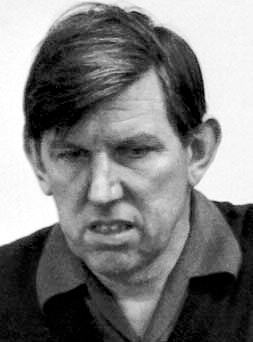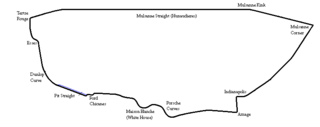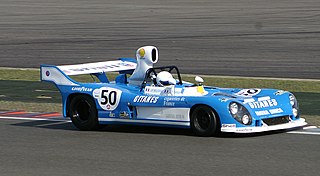The Tyrrell Racing Organisation was an auto racing team and Formula One constructor founded by Ken Tyrrell (1924–2001) which started racing in 1958 and started building its own cars in 1970. The team experienced its greatest success in the early 1970s, when it won three Drivers' Championships and one Constructors' Championship with Jackie Stewart. The team never reached such heights again, although it continued to win races through the 1970s and into the early 1980s, taking the final win for the Ford Cosworth DFV engine at Detroit in 1983. The team was bought by British American Tobacco in 1997 and completed its final season as Tyrrell in 1998. Tyrrell's legacy continues in Formula One as the Mercedes-AMG F1 team, who is Tyrrell's descendant through various sales and rebrandings via BAR, Honda and Brawn GP.

The 1968 Formula One season was the 22nd season of the FIA's Formula One motor racing. It featured the 19th FIA World Championship, which commenced on 1 January, and ended on 3 November after twelve races, and numerous non-championship races. Graham Hill won the second of his World Championship titles, with Lotus.

Jean-Pierre Maurice Georges Beltoise was a French Grand Prix motorcycle road racer and Formula One driver who raced for the Matra and BRM teams. He competed in 88 Grands Prix achieving a single victory, at the 1972 Monaco Grand Prix, and a total of eight podium finishes.

Robert Kenneth Tyrrell was a British Formula Two racing driver and the founder of the Tyrrell Formula One constructor.

The Matra Murena is a mid-engined, rear wheel drive sports car that was produced from 1980 through 1983 by the French engineering group Matra. The factory was located in the commune of Romorantin-Lanthenay in the department of Loir-et-Cher in central France.

The 1975 24 Hours of Le Mans was the 43rd Grand Prix of Endurance, and took place on 14 and 15 June 1975. Colloquially called the “Le Mans Economy Run”, stringent refuelling regulations were put in place. Unable to match the requisite 7mpg fuel economy the manufacturer teams from Ferrari, Alfa Romeo withdrew and Matra had retired from the sport at the end of 1974. Therefore, this only left Gulf and Ligier as front-running works-teams.

The 1974 24 Hours of Le Mans was the 42nd Grand Prix of Endurance, and took place on 15 and 16 June 1974. It was the fifth round of the 1974 World Championship for Makes. After Alfa Romeo had won the first race of the season at Monza, it had been Matra all the way and they came to Le Mans as firm favourites for a third consecutive outright victory, especially after Alfa Romeo withdrew its cars just before raceweek.

The 1973 24 Hours of Le Mans was the 41st Grand Prix of Endurance and took place on 9 and 10 June 1973. It was the eighth round of the 1973 World Championship of Makes.
Four-wheel drive (4WD) has only been tried a handful of times in Formula One. In the World Championship era since 1950, only eight such cars are known to have been built.

The 1967 Spanish Grand Prix was a Formula One non-championship race held at Jarama on 12 November 1967.

The Matra MS5 is a Formula Two and Formula Three racing car, designed, developed, and made by Matra, which was used in the Formula Two class of two World Championship Grands Prix in 1966 and 1967. It was actively used in motor racing competitions between 1965 and 1969.

The Matra-Simca MS670 was a Group 5 prototype race car introduced in 1972 for the World Championship for Makes. The MS670 replaced the previous Matra-Simca MS660C.
The Matra MS620 was a Group 6 sports prototype built by Matra in 1966, and was the second such car built by the company. Fitted with a 1.9 litre version of the BRM Formula One V8 engine, four cars were built, but were mostly used as developmental cars. In 1967, the MS620 was replaced by the 3 litre Matra MS630, although it was used in the Le Mans Test of that year, fitted with a 4.7 litre Ford V8 engine.

The Matra Company's racing team, under the names of Matra Sports, Equipe Matra Elf and Equipe Matra Sports, was formed in 1965 and based at Champagne-sur-Seine (1965–1967), Romorantin-Lanthenay (1967–1969) and Vélizy-Villacoublay (1969–1979). In 1979 the team was taken over by Peugeot and renamed as Automobiles Talbot.

The Trophée Craven 'A', was the fifth round of the 1966 Trophées de France. This was held on the Bugatti au Mans, located in Le Mans, Maine, France, on 18 September. The following July, the circuit was home to the 1967 French Grand Prix, of which all three drivers on the podium that afternoon – Jack Brabham, Denny Hulme and Jackie Stewart – raced in this event.

The Matra MS11 is a Formula One car used by the Matra team during the 1968 Formula One season, developed from the successful MS7 F2 car. It was relatively unsuccessful compared to its sibling, the Cosworth DFV powered Matra MS10 which Jackie Stewart drove to second place in the World Drivers' Championship. The major problems were with the V12 engine, which was thirsty, underpowered, unreliable and prone to overheating. The car was raced almost exclusively by Jean-Pierre Beltoise with Henri Pescarolo driving a second car at the end of the season. Its best outing came at the 1968 Dutch Grand Prix where Beltoise finished second behind Stewart, and recorded the fastest lap. In 1969, Matra set aside the V12 project, concentrating on the DFV-powered MS80.

The Matra MS10 is a Formula One car entered by the Matra International team during the 1968 Formula One season. It, along with its V12-powered sibling MS11, was Matra's first purpose-built F1 car and won three races in 1968, taking Jackie Stewart to second place in the Drivers' Championship and Matra International to third place in the Constructors' Championship.

The Matra MS120 was the fifth and final Formula One car produced by Matra.

The Matra-Simca MS630 was a Group 5 prototype race car introduced in 1967 for the World Championship for Makes. The MS630 replaced the previous Matra MS620. The car was initially designated as the Matra MS630, but when Simca sponsored Matra in 1969, it was renamed as the Matra-Simca MS630.
The Matra MS6 was an open-wheel Formula 2 racing car, designed, developed and built by Matra in 1966.













